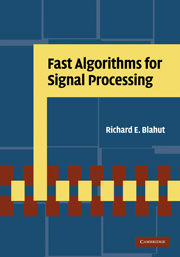Book contents
- Frontmatter
- Contents
- Preface
- Acknowledgments
- 1 Introduction
- 2 Introduction to abstract algebra
- 3 Fast algorithms for the discrete Fourier transform
- 4 Fast algorithms based on doubling strategies
- 5 Fast algorithms for short convolutions
- 6 Architecture of filters and transforms
- 7 Fast algorithms for solving Toeplitz systems
- 8 Fast algorithms for trellis search
- 9 Numbers and fields
- 10 Computation in finite fields and rings
- 11 Fast algorithms and multidimensional convolutions
- 12 Fast algorithms and multidimensional transforms
- A A collection of cyclic convolution algorithms
- B A collection of Winograd small FFT algorithms
- Bibliography
- Index
10 - Computation in finite fields and rings
Published online by Cambridge University Press: 03 May 2011
- Frontmatter
- Contents
- Preface
- Acknowledgments
- 1 Introduction
- 2 Introduction to abstract algebra
- 3 Fast algorithms for the discrete Fourier transform
- 4 Fast algorithms based on doubling strategies
- 5 Fast algorithms for short convolutions
- 6 Architecture of filters and transforms
- 7 Fast algorithms for solving Toeplitz systems
- 8 Fast algorithms for trellis search
- 9 Numbers and fields
- 10 Computation in finite fields and rings
- 11 Fast algorithms and multidimensional convolutions
- 12 Fast algorithms and multidimensional transforms
- A A collection of cyclic convolution algorithms
- B A collection of Winograd small FFT algorithms
- Bibliography
- Index
Summary
Signal-processing computations may arise naturally in a finite field, so it is appropriate to construct fast algorithms in the finite field GF(q). Computations in a finite field might also arise as a surrogate for a computation that originally arises in the real field or the complex field. In this situation, a computational task in one field is embedded into a different field, where that computational task is executed and the answer is passed back to the original field. There are several reasons why one might do this. It may be that the computation is easier to perform in the new field, so one saves work or can use a simpler implementation. It may be that devices that do arithmetic in one field may be readily available and can be used to do computations for a second field, if those computations are suitably reformulated. In other situations, one may want to devise a standard computational module that performs bulk computations and to use that module for a diversity of signal-processing tasks. In seeking standardization, one may want to fit one kind of computational task into a different kind of structure.
Another reason for using a surrogate field is to improve computational precision. Computations in a finite field are exact; there is no roundoff error. If a problem involving real or complex numbers can be embedded into a finite field to perform a calculation, it may be possible to reduce the computational noise in the answer.
Information
- Type
- Chapter
- Information
- Fast Algorithms for Signal Processing , pp. 311 - 344Publisher: Cambridge University PressPrint publication year: 2010
